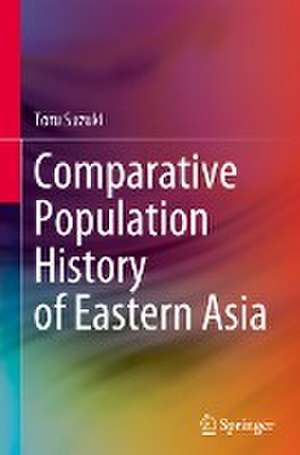Comparative Population History of Eastern Asia
Autor Toru Suzukien Limba Engleză Hardback – 15 feb 2024
Topics covered in this book include population growth, fertility, mortality, domestic and cross-border migration, marriage, divorce, and households. Contrasts between economic and population giants (China and Japan), former Japanese colonies (Korea and Taiwan), feudalism and Confucianism (Japan and others), and capitalism and socialism of the same ethnic groups (South and North Korea, Taiwan, and China) provide a fresh view of population dynamics in relation to political, economic, and cultural changes.
The population study of Eastern Asia has great importance. If economic development is checked by early and rapid aging, it functions to preserve the conventional Euro-centric world system and Pax Americana. On the other hand, if China succeeds in further development while sustaining a socialist dictatorship, it is a challenge to the authority of liberal democracy. If the institution of marriage remains robust and extramarital births do not increase in Eastern Asia, it implies that an aspect of family change is culturally dependent. This book provides clues to help answer such important questions.
Preț: 729.06 lei
Preț vechi: 889.09 lei
-18% Nou
Puncte Express: 1094
Preț estimativ în valută:
139.50€ • 145.65$ • 115.46£
139.50€ • 145.65$ • 115.46£
Carte tipărită la comandă
Livrare economică 05-19 aprilie
Preluare comenzi: 021 569.72.76
Specificații
ISBN-13: 9789819993666
ISBN-10: 9819993660
Pagini: 209
Ilustrații: IX, 209 p. 34 illus., 25 illus. in color.
Dimensiuni: 155 x 235 mm
Greutate: 0.49 kg
Ediția:1st ed. 2024
Editura: Springer Nature Singapore
Colecția Springer
Locul publicării:Singapore, Singapore
ISBN-10: 9819993660
Pagini: 209
Ilustrații: IX, 209 p. 34 illus., 25 illus. in color.
Dimensiuni: 155 x 235 mm
Greutate: 0.49 kg
Ediția:1st ed. 2024
Editura: Springer Nature Singapore
Colecția Springer
Locul publicării:Singapore, Singapore
Cuprins
Introduction – Present and Future of Eastern Asia.- Origins of Eastern Asian Peoples.- Socioeconomic and Demographic Transitions.- Population in Premodern Eastern Asia.- Population in Modern Eastern Asia.- Population in Contemporary Eastern Asia.- Concluding Remarks.
Notă biografică
Toru Suzuki, National Institute of Population and Social Security Research
Textul de pe ultima copertă
This book compares the population history of Japan, Korea, Taiwan, and China to understand such emergent changes as extremely low fertility in Korea and Taiwan, compressed urbanization and a massive diaspora from Korea, early population aging relative to economic development in China, and changing patterns of cross-border migration in the region. After discussing the origin of each ethnic group, premodern population changes are examined by reviewing historical demographic studies including those written in local languages. A new population estimation for premodern Korea is also presented.
Topics covered in this book include population growth, fertility, mortality, domestic and cross-border migration, marriage, divorce, and households. Contrasts between economic and population giants (China and Japan), former Japanese colonies (Korea and Taiwan), feudalism and Confucianism (Japan and others), and capitalism and socialism of the same ethnic groups (South and North Korea, Taiwan, and China) provide a fresh view of population dynamics in relation to political, economic, and cultural changes.
The population study of Eastern Asia has great importance. If economic development is checked by early and rapid aging, it functions to preserve the conventional Euro-centric world system and Pax Americana. On the other hand, if China succeeds in further development while sustaining a socialist dictatorship, it is a challenge to the authority of liberal democracy. If the institution of marriage remains robust and extramarital births do not increase in Eastern Asia, it implies that an aspect of family change is culturally dependent. This book provides clues to help answer such important questions.
Caracteristici
Presents a comparative cultural view of family patterns in Eastern Asia based on historical and anthropological findings Makes thorough reference to Japanese, Korean, and Chinese literature on demographic and economic changes Aims to achieve a deeper understanding of contemporary population issues from the long-term historical perspective
